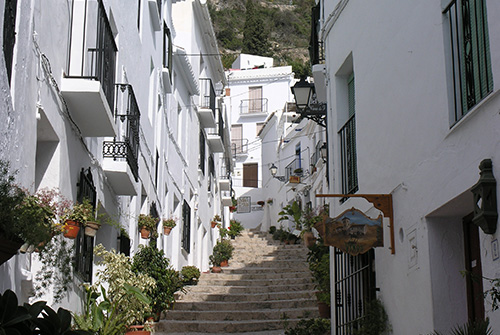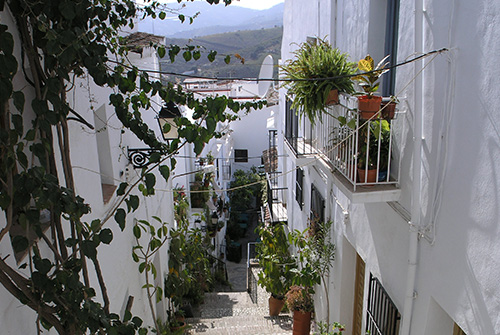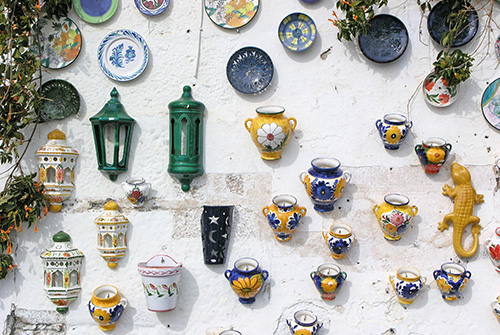Frigiliana
Frigiliana is just 7 kilometres north and inland from the coast at Nerja to which it is linked by several daily buses. It is definitely worth visiting this typical Andalucian mountain village during your stay in Nerja – allow a couple of hours for your visit to give you time to explore the narrow streets and stop for a drink at the viewpoint at the top.
Situated in the foothills of the Sierra de Enmedio, a southern extension of the Almijara mountain range, Frigiliana is an extremely pretty village which has received several awards for conservation and beauty. It enjoys spectacular countryside as well as wonderful sea views and provides an alternative to staying in Nerja itself for those who wish to experience more of rural Spain whilst still being only a short drive from the beach and the shops and amenities of Nerja.
Frigiliana consists of two adjoining centres. One of Moorish & Medieval origin and the other constructed recently whilst imitating the architectural style of the old village. Between the two districts there are two interesting buildings, the former Granary built in 1767 and a 16th century Renaissance Palace which is now a molasses factory.
Within the old sector, the narrow, winding streets are full of interesting shops and bars, and twelve mosaics by the artist Pilar Garcia Millan depict the village’s history. At the high point of the town there are remains of a Moorish castle. The parish church of San Antonio is of 16th century construction and houses three excellent 17th century paintings.
Settlement of the area originated in prehistoric times and archaeological sites date back to 3000-1500 BC. Phoenician and Roman remains have also been discovered.
El Acebuchal
Acebuchal is an exceptionally beautiful hamlet situated right in the heart of the Sierras of Tejeda, Almijara and Alhama Natural Park. It sits almost on the border between Frigiliana and Competa. There are various names associated with the village of El Acebuchal – “the Lost Village” and “the Ghost Village – el Pueblo Fantasma,” are the two that seem to be most commonly used.
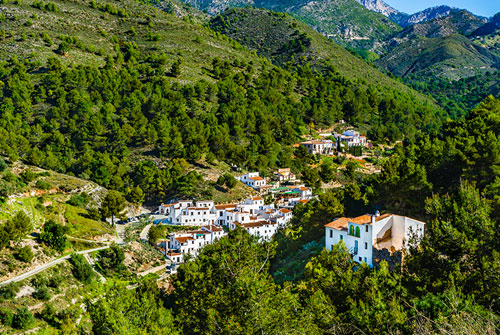 As with so many villages in the area, Frigiliana and Acebuchal suffered terribly during the Spanish Civil War. Frigiliana was declared ‘Red,’ (Republican) in July of 1936. The Fascists quickly retook the village in February of 1937 and took their revenge on anyone suspected of being communist. After the Civil War ended, Franco’s attention turned to the resistance movements and a long period of fighting between the facsists and the guerillas began, lasting until 1952, with Frigiliana and El Acebuchal right in the front line.
As with so many villages in the area, Frigiliana and Acebuchal suffered terribly during the Spanish Civil War. Frigiliana was declared ‘Red,’ (Republican) in July of 1936. The Fascists quickly retook the village in February of 1937 and took their revenge on anyone suspected of being communist. After the Civil War ended, Franco’s attention turned to the resistance movements and a long period of fighting between the facsists and the guerillas began, lasting until 1952, with Frigiliana and El Acebuchal right in the front line.
In the summer of 1948 the authorities ordered the residents of Acebuchal (some 200 people) to leave their homes (the village had long been suspected of providing refuge and food to the guerrillas) and so the village is left empty and abandoned.
The ‘ghost’ village of Acebuchal remained abandoned until 1998 when one man – Antonio “El Zumbo” fulfilled a lifelong dream and returned to Acebuchal and began to rebuild the village bit-by-bit. The results are nothing short of spectacular, bearing in mind that everything was done by hand and there wasn’t even electricity or water until 2003.
Antonio’s family now run a successful restaurant and rural hotel in the village. The food is fantastic, most of the produce is grown locally and organically. More information can be found on the restaurant’s website. This is the only bar/restaurant in the village so it is wise to call ahead to check opening times if you are planning a visit!
El Acebuchal can be reached via a 2 hour walk from Frigiliana, or by car (with the last part on an unmade track, passable with care).
Cómpeta
The traditional white Andalusian village of Cómpeta lies at the foot of the Sierra Tejeda and Almijara mountain ranges, some 15km inland. To reach it from Nerja take the motorway towards Málaga and come off at exit 285 – “Torrox, Cómpeta” , then follow the A-7207 for approximately 15 km until you reach Cómpeta.
Located seven hundred metres above sea level, Cómpeta provides stunning views of the surrounding mountains, countryside and the sea. The old town is made up of a labyrinth of cobbled streets that date back to Moorish times, with the Plaza Almijara at its centre, an ideal place to sit and have a drink or snack at one of the bars or restaurants and watch the world go by.
There is an old saying in the village – ‘A day without going to the square is a day without living’ and it has been the heart of the village for centuries. The square is dominated by the 16th century church La Asunción whose tower is one of the most well-known landmarks in the village.
One of the most popular annual fiestas here is the Noche del Vino (Night of the Wine) on the 15th August which features a programme of flamenco and sevillana music and dance, plus plenty of free-flowing wine. Cómpeta is well-known for its sweet wine produced from the Moscatel grapes that grow in the area.
Cómpeta also makes an ideal base for walking in the Natural Park of the Sierra Tejeda and Almijara mountain ranges. Walking routes are available at the Tourist Office and the bookshops also sell books on the subject.
Other White Villages In The Axarquia Region
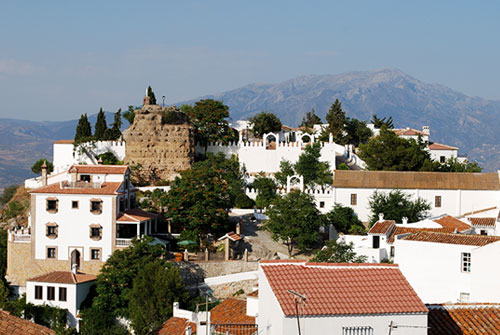 By travelling only about 20 minutes from Nerja along the motorway towards Málaga you reach the regional capital of this mountainous area, Vélez-Málaga. This is a market town well worth a visit with a lively market on Thursday. The limestone mountain range of the Sierra Almijara, part of the immense Sierras of Tejeda, Almijara and Alhama Natural Park that straddles Malaga and Granada provinces, looms over this stretch of coastline, as seen in the pretty mountain village of Torrox which is just a 15 minute drive from Nerja. Torrox, known as Torrox Pueblo (Torrox Village), to distinguish it from the seaside resort of Torrox Costa, is well worth a visit.
By travelling only about 20 minutes from Nerja along the motorway towards Málaga you reach the regional capital of this mountainous area, Vélez-Málaga. This is a market town well worth a visit with a lively market on Thursday. The limestone mountain range of the Sierra Almijara, part of the immense Sierras of Tejeda, Almijara and Alhama Natural Park that straddles Malaga and Granada provinces, looms over this stretch of coastline, as seen in the pretty mountain village of Torrox which is just a 15 minute drive from Nerja. Torrox, known as Torrox Pueblo (Torrox Village), to distinguish it from the seaside resort of Torrox Costa, is well worth a visit.
There are a couple of churches and lots of quaint side streets, and the lovely views from the village towards the mountains and the sea complete the picture. The main square also has a number of restaurants/cafeterias where you can sit in the sun and relax and enjoy the tranquillity of this small village.
To the west of the park and about 50km from Nerja is Comares, one of the highest villages in Andalucia and visible for miles around. Perched on the top of a hill some 740 metres above sea level, it affords some stunning views across the majestic landscape, to the coast, lake and mountains. This white village was originally Muslim and it stands out for the traces of its Arabic past and its medieval period.
Further inland you will find Colmenar, on the edge of the densely wooded Montes de Malaga Natural Park and named after the numerous beehives (colmenas) that produce the village´s honey.


